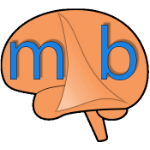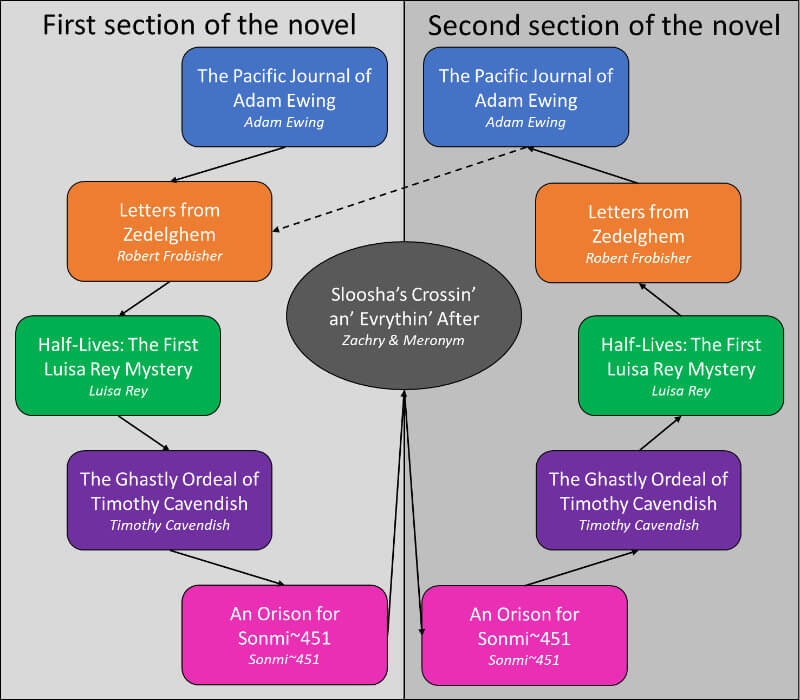This post is part of a larger deep dive
Curious about the role of Buddhism and Nietzsche’s Eternal Recurrence idea in Cloud Atlas? Check out Cloud Atlas Explained!
Or read the full Cloud Atlas article!
This post is part of a larger deep dive
Curious about the role of Buddhism and Nietzsche’s Eternal Recurrence idea in Cloud Atlas? Check out Cloud Atlas Explained!
Or read the full Cloud Atlas article!
Author: David Mitchell
Publisher: Random House
Year: 2004
Language: English
Country: UK
Number_of_pages: 544

Our rating

Your rating
If there was a book that taught me that first impressions can be deceiving, that would have to be Cloud Atlas.
As I began reading the first chapter, I was so utterly confused and bored that I considered giving up… As I kept reading however, I became completely absorbed!
I literally went from one extreme to the other!
Not being accustomed to the particular writing style of what looked like a book written in the middle ages, I have to admit I struggled at the beginning. However, after persevering the first few pages, the book took me through all sorts of genre: there was history, science fiction, thriller, drama, comedy – you name it!
The truth is… I couldn’t stop reading it!
Cloud Atlas feels almost like an anthology. The book is divided into 6 different but loosely inter-connected stories happening at different periods of time.
In “The Pacific Journal of Adam Ewing”, Adam Ewing is an American notary holding white-supremacy beliefs, who is traveling on board of the ship “The Prophetess” on a journey from Hawaii en route to California. Ewing’s doctor, Dr. Goose, informs him that he is suffering from a viral infection, and begins treatment immediately. At some point, Ewing finds that a slave from the Morori tribe had stowed away in Ewing’s quarters and the two begin a friendship.
The second story, “Letters from Zedelghem” happens around the 1930’s. Robert Frobisher is a bisexual musician who had been disinherited by his father. To re-gain his reputation he looks for a job as an amanuensis for renowned composer Vyvyan Ayrs, who, due to syphilis, cannot transcribe music anymore. Ayrs is convinced of Frobisher’s talent and decides to hire him, even though Frobisher dislikes Ayrs’ disagreable nature. One day, Frobisher finds one half of Ewing’s diary in Ayrs library and becomes intrigued by Ewing’s story. He also writes about his thoughts and experiences to his friend and lover Rufus Sixsmith.
The third story, “Half-Lives: The First Luisa Rey Mystery”, takes place in 1975. Luisa Rey is a tenacious journalist who meets an older Rufus Sixsmith (Frobisher’s lover in the previous story) in a lift. Sixsmith is in possession of secret and dangerous information regarding a local nuclear plant and decides to share it with Rey, setting off a series of dangerous events that threaten Rey’s life.
“The Ghastly Ordeal of Timothy Cavendish” happens a few years later after Rey’s story. Timothy Cavendish is a retired British publisher who becomes embroiled in a money dispute with gangsters related to his latest client. Cavendish seeks help from his brother, who fools him into checking in to a retirement home. A desperate Cavendish tries his best to escape the suffocating situation.
The fifth story, “An Orison for Sonmi~451”, is set in Korea, in an undisclosed far future. Enslaved clones work in humiliating conditions in a fast-food restaurant. One of these clones, Sonmi~451, is saved by a group of anti-government rebels, who show her the true reality of life for the clones.
The sixth story, “Sloosha’s Crossin’ an’ Evrythin’ After”, takes place way far into the future. Old man Zachry tells the story of an apocalyptic event that decimated most of the Earth’s population. Some humans, the Prescients, survived and use advanced technology to study a group of people in an island, which Zachry and his family live in. One of the Prescients, Meronym, travels to the island and asks Zachry to help her find the top of a volcano.

The organisation of the book is very interesting. It starts chronologically, with each chapter presenting one half of the narrative (from Ewing’s to Sonmi~451’s story). The middle story narrating the adventures of Zachry and Meronym is told in its entirety. The second part of the remaining stories are then told in reverse chronological order (i.e., starting with Sonmi~451 and ending with Ewing; see figure above).
Thus, “Sloosha’s Crossin’ an’ Evrythin’ After” functions as a mirror, connecting the two halves of each seemingly independent story.
For a book of about 544 pages, it almost reads like a novella. Each story develops at the just the right pace. Particularly interesting was Mitchell’s decision to incorporate such diverse genres for the narratives – there is action (e.g., Sonmi), drama (e.g., Frobisher) and thriller (e.g., Rey) to keep you engaged from beginning to end. It surely must require a shedload of talent as a writer to excel in pretty much every genre.
In fact, my initial apprehension regarding Ewing’s chapter is likely a consequence of the authenticity to which Mitchell depicted that particular era. Mitchell seemed to have researched the writing style of 19th century journals, and made extensive use of archaic words (e.g., betwixt) and spelling (e.g., trowzers). I should also mention that “Sloosha’s Crossin’ an’ Evrythin’ After” is a rather difficult read, mostly due to the usage of a kind of pidgin English, which takes a bit of time to get into.
The main characters have captivating personalities and are identifiable, but none of them could be considered the paragon of virtue. And that’s a good thing. You see, there is an interesting and natural progression towards self-discovery and personal growth in each and every character; this is, in fact, one of the main themes of the book, as I explain below.
The inexplicable birthmark shared by some of the characters at different epochs adds to a type of weirdness that is intriguing and involving, rather than confusing and spooky.
As you read the different chapters you’ll notice that you are reading completely different and independent stories. Curiously though, they will all feel strangely connected. Mitchell was careful not to overdo this point, with characters only making brief and casual comments about an earlier character (e.g., Frobisher reading Ewing’s diary; Rey listening to Frobisher’s musical composition; Cavendish coming across Rey’s novel; Sonmi watching a movie about Cavendish’s life; Zachry’s reverence for Sonmi).
The ending of each story is unpredictable and will not disappoint.
All in all, this is an excellent book. It takes a little bit of patience to get used to the writing style, but if you persevere, you’ll be rewarded with an absolutely fascinating story.
My only advice to you is: read the book before you watch the film. Even if this recommendation arrives too late, try to read the book as well, as it is a completely different experience.
That isn’t to say that the film is not worth it. However, in my opinion, the novel really brings out a much more intimate connection with each character, which you will need, to fully appreciate the inherent but subtle bizzareness in the novel.
To me, Cloud Atlas is one of the best books I have ever read, and for that reason it gets a star rating of 5.
The book is definitely on the weird spectrum. Remarkably, each individual story isn’t weird at all. So where is the weirdness coming from?
I believe the knowledge that some of characters are somehow intrinsically connected (via the birthmark), changes our perception of the story at a global level. That is, each story cannot be considered independent anymore; all stories are seemingly connected via a mysterious link invisible to the eyes of every character.
With such a subtle link, it’s rather astonishing that it has the capacity to evoke an actual sense of weirdness.
Cloud Atlas gets a bizarrometer score of 2.5.
The birthmark, the birthmark, the birthmark…
Surely, this is all you can think about. Why do some of the characters share the birthmark in the shape of a comet? Can it be coincidence? What is the meaning of it?
Unusual to many authors, Mitchel actually provided a hint during one interview for BBC Radio 4’s Bookclub. Here it is:
“Literally all of the characters, except one, are reincarnations of the same soul in different bodies throughout the novel identified by a birthmark […] I guess that’s just a symbol really of the universality of human nature. The title “Cloud Atlas” itself, the cloud refers to the ever changing manifestations of the Atlas, which is the fixed human nature which is always thus and ever shall be. So the book’s theme is predacity, the way individuals prey on individuals, groups on groups, nations on nations, tribes on tribes. So I just take this theme and in a sense reincarnate that theme in a different context.”
Interestingly, Mitchel has expressed his disbelief in reincarnation:
“Reincarnation is a beautiful and elegant theory and I wish I could believe in it… But, alas, I can’t, no…”
However, in an interview for Chatelaine he added:
“[there is] solace in the notion we can have another go and try and fix things and make a better job. Reincarnation is a useful idea. […] Even in one life we metaphorically die and are reborn a number of times. […] The first time you’re unceremoniously dumped is a kind of death. And you come back from it. Marriage — one former way of life has to die to make the marriage work.”
So, which of the characters are the reincarnations?
As we will describe in greater detail below, Frobisher, Rey, Sonmi~451 and Meronym all possess the birthmark. Nowhere in the book is specified that Ewing has a birthmark, but it is implied he does, given that Rey experiences an inexplicable connection with the ship Ewing was sailing on (e.g., her birthmark “throbs”).
Cavendish and Rey were both alive at some time point. Rey has a birthmark and seems connected to Ewing, so Cavendish may or may not be a reincarnation. It will depend on whether you’re willing to believe that Frobisher’s death resulted in his soul being split into two and inhabit both Rey and Cavendish during the same epoch.
Zachry is perhaps the most crucial character in the entire novel. Having the features of an unreliable narrator, it is possible that everything he’s telling is fictional: Ewing is a character in the journal-turned-book Frobisher is reading; Frobisher is a character in Rey’s letters; Rey is a character from a novel read by Cavendish; Cavendish is a character from a movie watched by Sonmi; Sonmi is a fictional goddess venerated by Zachry.
Can it all be that simple though? I don’t think so. In my opinion, Cloud Atlas is about literal reincarnation, and the idea that every human being is deeply connected both to past and future incarnates.
Borrowing Nietzsche’s idea of Eternal Recurrence (i.e., that our lives will be lived an infinite amount of times), each character is influenced by both preceding and succeeding incarnates’ behaviour with every recurrence.
Ultimately, the message of the book could be all about becoming better individuals and, perhaps, even leave an important mark on their own timelines.
Leave a comment
Add Your Recommendations
Popular Tags